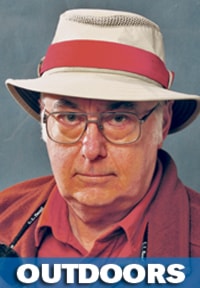I once served on a provincial board with a high-ranking government official who was fond of saying “policy is a cage to confine monkeys.”
That saying came back to me when I got my first look at Alberta’s draft Fish Stocking Policy, which not only cages simians, but makes monkeys of every angler in Alberta. What bothered me is that the entire 12 - page document seemed to have little to do with fish stocking policy, so much as being a pecking order protocol for officials to make ad hoc fish stocking decisions with as little input as possible from the people who pay the bills: the anglers of Alberta.
I am not alone in my views. Dr. Darryl Smith, Fish Committee Chairman of the Alberta Fish and Game Association is plainly disappointed.
“At first glance this policy appears to be limited by a narrow focus,” Dr. Smith comments, “it lacks recognition of innovation, of new science/technology and does not fully recognize the importance of having a robust fish culture program in Alberta.
Stakeholder involvement as part of setting fishery management objectives is mentioned, but overall the document appears to suggest that these will still be largely determined internally.”
Ray Makowecki, a past AFGA president, environmental and fisheries consultant, and retired as an Alberta Fish and Wildlife division biologist, says, bluntly, that the draft fish stocking policy is really a manual on the roles and responsibilities of government personnel and other non-policy subjects; “it does not constitute an acceptable policy of the Government of Alberta.”
To constitute a fish stocking policy, Makowecki says, the document would have to relate to basic fishery management questions, such as: do we want more or fewer anglers in Alberta?
This document, Makowecki says, totally fails to answer questions about where should be going, for example: Do we need new hatcheries and rearing stations? Should we create new and restore old habitats? Should we reintroduce native species? Do we need to improve access to the stocked waters we have? Should we allow the stocking of perch in private ponds? Should we create put-and-take walleye fisheries? Should we shorten and simplify our regulations?
Randy Collins, another AFGA past president, is concerned with formerly great Alberta stocked fisheries that are in decline, such as Lake Isle, Carson and Hasse Lakes, and with the mindless stocking of Albertans’ favorite fish to catch and eat, the walleye.
Why, for example, dump five million walleye fry in Wabamun Lake, where you can’t keep or eat any?
“Angling in Alberta has changed and not for the better,” Collins says, “so let’s have a policy that involves locals, stakeholders and all anglers, that allows some harvest, has a diversity in species being stocked, and is supported by a hatchery that is capable, current, and world class.”
Something like the Manitoba Parklands, for example, where a consortium of anglers, with the help of a very few biologists has created North America’s most exciting fishery by stocking prairie-parkland potholes, lakes and reservoirs with a wide variety of species: rainbow, brown and brook trout, splake (lake - brook trout cross), tiger trout (brook-brown cross), walleye, even pike and perch.
The last time anything like that happened in Alberta was 20 - 30 years ago when a group of anglers shamed our biologists into stocking some big brown trout breeders into the Red Deer River tail water, which has resulted in an exciting new fishery for limited numbers of trophy browns. Meanwhile, the biologists decree a zero limit on abundant Red Deer walleyes, then wonder why the rocky mountain whitefish numbers are down.
Habitat-stocking initiatives are few and far between in Alberta. Recent columns have been full of the North Raven River Restoration, a project of the mid ‘70s that produced Alberta’s top trout stream. In the late ‘50’s, to preserve and protect the species, west slope cutthroats were stocked in the North and South Ram Rivers where no fish existed above impassable falls.
Now we have few places left to try to stock, to preserve and protect our provincial fish, the threatened bull trout, that have not been destroyed by clear cut logging and stupid, ruinous oil and gas development practices with too many roads everywhere, all with impassable, overhanging culverts.
It seems never to have occurred to anyone that they might be able to create a last bastion for Alberta’s beleaguered bull trout by planting them in that same Ram system that has worked out so well for the west slope cutthroats. Historically, after all, cuts and bulls have coexisted in Alberta’s east slopes rivers and streams.
But no, we get fish stocking gobbledygook on how a boggle of biologists and technicians might finally get around to actually doing something. Perhaps a true combined Alberta Fish Stocking and Management Policy could be reduced to one line: “Non-native fish will no longer be stocked to protect native fish; native bull and cutthroat trout will be sacrificed to support the Alberta advantage.”
Caged or not, the monkeys run this place.
Bob Scammell is an award-winning columnist who lives in Red Deer. He can be reached at bscam@telusplanet.net.
